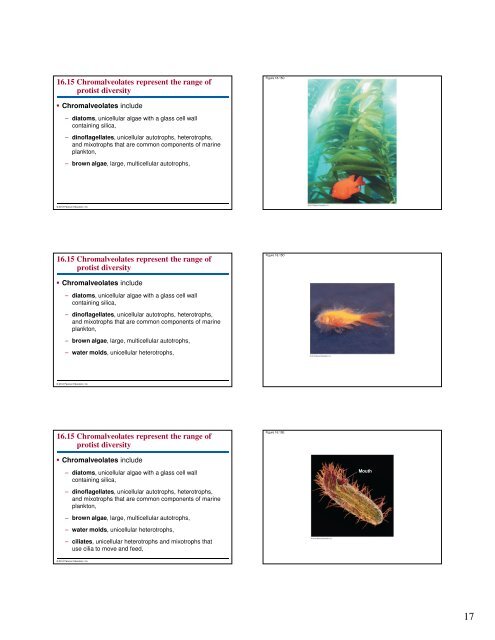Microbial Life: Prokaryotes and Protists - Renz Science
Microbial Life: Prokaryotes and Protists - Renz Science
Microbial Life: Prokaryotes and Protists - Renz Science
You also want an ePaper? Increase the reach of your titles
YUMPU automatically turns print PDFs into web optimized ePapers that Google loves.
16.15 Chromalveolates represent the range ofprotist diversityFigure 16.15C Chromalveolates include– diatoms, unicellular algae with a glass cell wallcontaining silica,– dinoflagellates, unicellular autotrophs, heterotrophs,<strong>and</strong> mixotrophs that are common components of marineplankton,– brown algae, large, multicellular autotrophs,© 2012 Pearson Education, Inc.16.15 Chromalveolates represent the range ofprotist diversityFigure 16.15D Chromalveolates include– diatoms, unicellular algae with a glass cell wallcontaining silica,– dinoflagellates, unicellular autotrophs, heterotrophs,<strong>and</strong> mixotrophs that are common components of marineplankton,– brown algae, large, multicellular autotrophs,– water molds, unicellular heterotrophs,© 2012 Pearson Education, Inc.16.15 Chromalveolates represent the range ofprotist diversityFigure 16.15E Chromalveolates include– diatoms, unicellular algae with a glass cell wallcontaining silica,Mouth– dinoflagellates, unicellular autotrophs, heterotrophs,<strong>and</strong> mixotrophs that are common components of marineplankton,– brown algae, large, multicellular autotrophs,– water molds, unicellular heterotrophs,– ciliates, unicellular heterotrophs <strong>and</strong> mixotrophs thatuse cilia to move <strong>and</strong> feed,© 2012 Pearson Education, Inc.17


